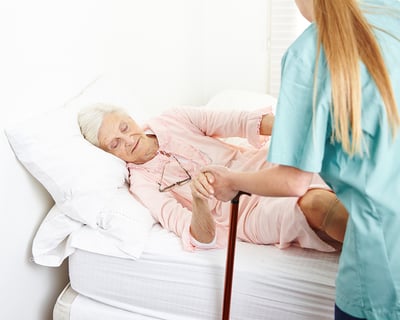 We often talk about the emotional difficulties of being a family caregiver, but there are plenty of physical challenges too. One of the questions that comes up most often is how to change the sheets when your aging or sick loved one can't be moved from the bed.
We often talk about the emotional difficulties of being a family caregiver, but there are plenty of physical challenges too. One of the questions that comes up most often is how to change the sheets when your aging or sick loved one can't be moved from the bed.
Changing sheets regularly is important for the health and hygiene of your loved one. It’s a critical step toward preventing infections and bedsores. Refreshing an occupied bed isn’t easy, but it’s certainly possible.
Let's break down the nine steps involved in resetting a bed while a person is still in it.
9 Steps to Changing an Occupied Bed
1. Find a partner to help.
If possible, enlist a family member or friend for assistance. While it's possible to change an occupied bed on your own, the task is significantly easier when done by two people.
2. Wash and glove your hands.
Good hygiene is an essential part of any physical caregiving task. For your safety and the safety of your loved one, thoroughly wash your hands before you start changing linens.
Gloves add a second level of protection.
3. Greet the person and explain what you’re about to do.
Changing the sheets on an occupied bed can be awkward for both the caregiver and the bedridden individual. If you’re caring for a close family member, the task can be emotionally draining as well.
To mitigate discomfort, take a moment to greet the person in bed. If you’re caring for a patient rather than a loved one, introduce yourself. Regardless of the relationship, a friendly greeting and explanation of your intentions is key to preserving dignity.
4. Gently secure and stabilize your loved one.
Using your hands, help the person roll onto one side of the bed in a position that’s comfortable and secure. If the person can help by holding onto the bed rail, encourage them to do so — it will make this step faster and easier.
5. Prepare the sheets.
Standing on the opposite of the bed as your loved one, remove the tucked‑in part of the sheet and roll it toward them. Next, take a clean sheet and roll it onto the exposed part of the mattress. Then gently help your loved one roll onto the side of the bed with the new, clean sheet.
6. Finish swapping the dirty sheet for the clean sheet.
With your loved one still on their side, remove the old sheet and finish putting on the new one. Four hands are much better than two in this case. One person can hold the sheet on one side while the other pulls it taut.
Once the sheet covers the bed completely, pull it tight on all sides to ensure that it’s free of wrinkles. Then secure it by tucking in the edges using hospital corners.
7. Change the pillowcase.
Slide one hand under your loved one’s head while you use the other to gently pull the pillow out and away from the bed. Lower their head gently to the mattress. Next, remove the cover and replace it with a clean pillowcase. Then, using the same gentle care, slide the pillow back under your loved one’s head.
8. Check in with the person in your care.
Before covering your loved one with a clean flat sheet and blanket, check in. Ask if they’re comfortable. Check to see if there are any wrinkles that need to be pulled tight. If all is well, finish up with a clean top sheet and coverlet.
9. Remove gloves and wash your hands.
Dispose of your gloves, then repeat the handwashing process. You’re done!
Remember, changing the sheets of an occupied bed isn’t easy, but it’s necessary. By doing this regularly, you’re boosting your loved one’s comfort and dignity as well as keeping infections at bay.
The video below includes a helpful demonstration of how to safely and comfortably change the bed
with someone in it.
Read through the steps above or watch the demonstration every time you change the sheets. By doing so, you’re promoting good hygiene and improving your loved one's quality of life. And the good news? The more you perform this task, the easier it becomes.

